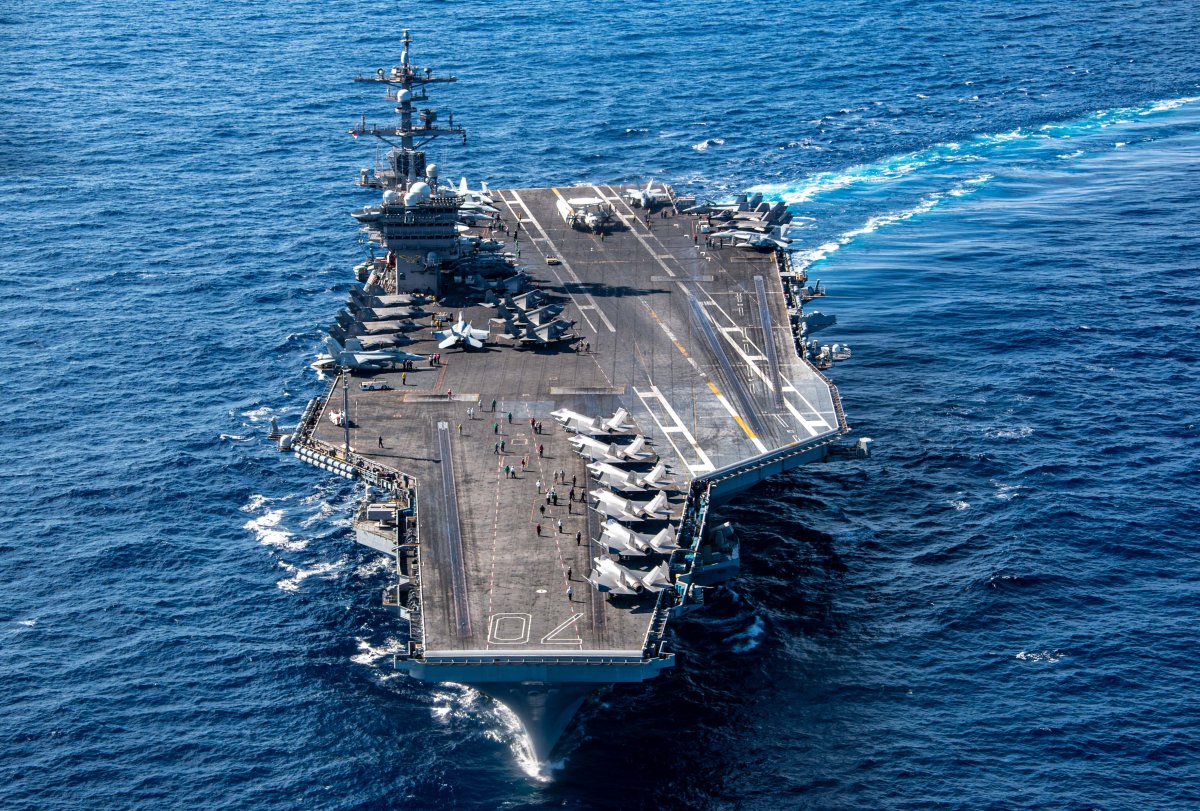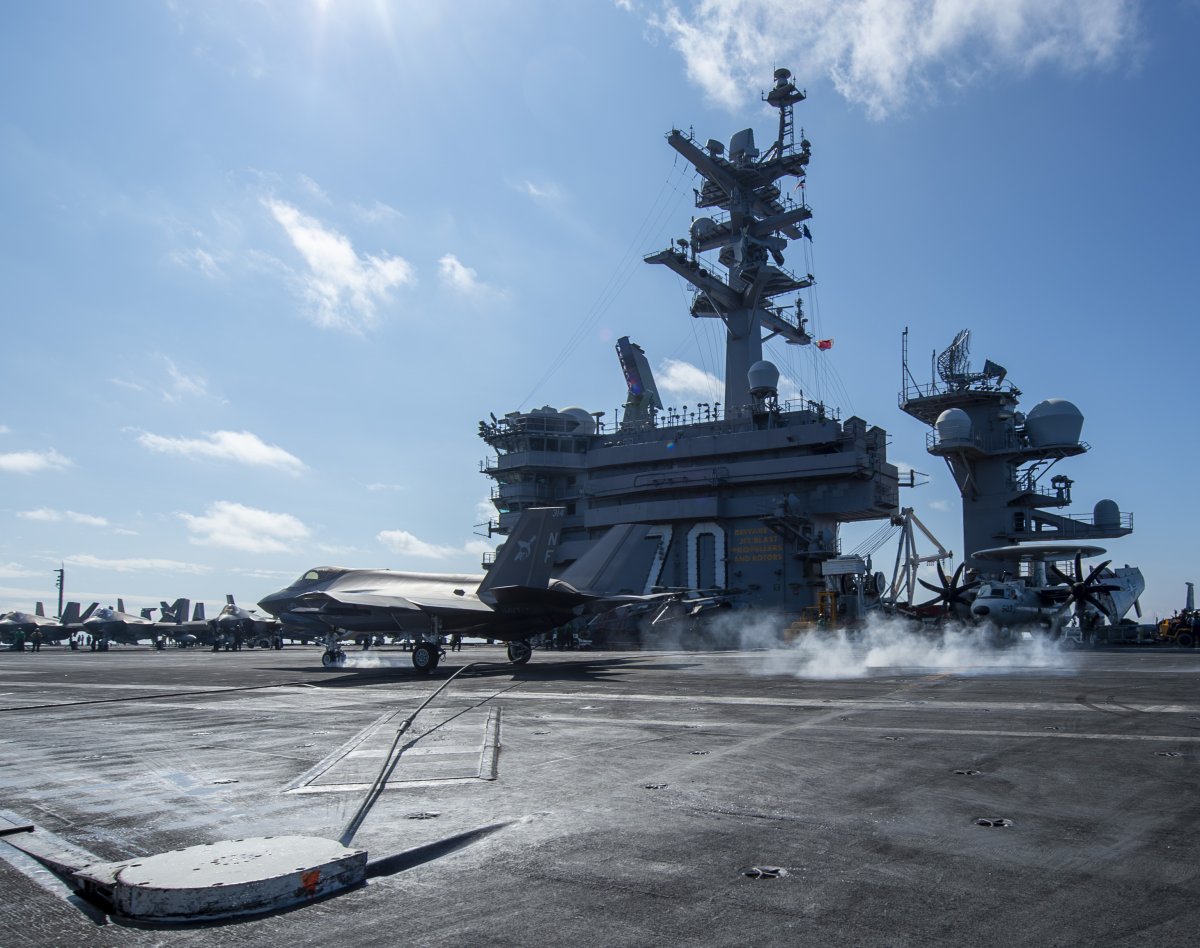A United States aircraft carrier received additional firepower during its deployment in the Western Pacific Ocean, following a large Chinese war game conducted in the contested Taiwanese waters.
According to photos published by the U.S. Navy on Saturday, USS Carl Vinson, one of the 11 American nuclear-powered aircraft carriers in service, transited the Philippine Sea, a marginal sea of the Western Pacific Ocean, with six additional F-35C Lightning II fighter jets the previous day.
The stealth aircraft are assigned to the Strike Fighter Squadron 147, which is based out of Marine Corps Air Station Iwakuni in Japan. It is part of the Carrier Air Wing Five, an operational naval aviation organization attached to the Japan-based U.S. aircraft carrier, USS George Washington.

The U.S. Navy has claimed that the F-35C is its most capable fighter jet and the backbone of its air superiority, which can enhance American power projection and deterrence. Newsweek has reached out to the service for further information regarding the additional F-35C deployment via email.
The reinforcement of the Lightning IIs, which are said to be the first and world's only long-range stealth strike fighters designed and built explicitly for U.S. aircraft carrier operations, came after the Chinese military reportedly mobilized 90 ships for a three-day exercise around Taiwan.
The areas of the exercise also included Japan's southern islands, the East China Sea, and the South China Sea. Under a U.S. defense concept, Japan and Taiwan form a north-south blockade with the Philippines against China, the first island chain, which is the western border of the Philippine Sea.
China has viewed the self-ruled Taiwan as part of its territory despite never having governed it and refused to renounce the use of force against the island. While the U.S. recognizes Beijing as the only government of China, it acknowledges, without endorsing, the Chinese claim over Taiwan.

On Friday, the Chinese Defense Ministry responded to its war game for the first time, claiming it "will decide whether and when to conduct military exercises in accordance with the needs and the situation on the ground," according to the ministry spokesperson Senior Colonel Wu Qian.
China's armed forces will keep fighting against "Taiwan independence" and promoting national reunification, Wu warned. Lai Ching-te, the Taiwanese president who is viewed by Beijing as a "separatist," made stopovers in Hawaii and Guam during his recent visit to the South Pacific allies.
"U.S. Indo-Pacific Command forces perform operations in and around critical sea passages and trade thoroughfares to deter threats that create regional instability and impinge on the free flow of goods, people, and ideas," the U.S. Navy said in one of the Carl Vinson's photo captions.

The Miyako Strait and the Luzon Strait are located on the western border of the Philippine Sea, connecting it with the East China Sea and the South China Sea, respectively. Both waterways serve as major gateways for the Chinese navy and air force for deployment to the wider Pacific Ocean.
Both straits are situated near Taiwan. The Miyako Strait is within Japan's Ryukyu Islands, northeast of Taiwan, and the Luzon Strait lies between Taiwan to the north and the Philippines to the south.
The Chinese Defense Ministry did not immediately respond to a request for comment by email.
The California-based Carl Vinson left its West Coast home port—Naval Air Station North Island in San Diego—on November 18 for a Pacific Ocean deployment, while the George Washington returned to Yokosuka naval base in Japan on November 22, Newsweek's weekly update showed.
The Carl Vinson is deployed with the Carrier Air Wing Two, which is composed of nine aircraft squadrons, including the Strike Fighter Squadron 97 that operates with the F-35C, according to the U.S. Naval Institute News. A complete F-35C squadron is fielded with 14 stealth aircraft since 2021.
This means the Carl Vinson was operating with at least two F-35C squadrons as of Friday.
Lockheed Martin, a U.S. defense contractor and manufacturer, claimed that the Lightning II's stealth performance enables aviators to evade detection and operate in anti-access and contested environments, which attempt to prevent and limit them from entering and operating in the area.
The aircraft has an unrefueled range of over 1,380 miles and carries more than 18,000 pounds of weapons that are held internally and externally. It is capable of flying at a top speed of 1,200 mph while equipped with a full internal weapons load of over 5,000 pounds, Lockheed Martin said.



















:quality(85):upscale()/2024/04/24/878/n/3019466/36c5693c662965c5d1ce91.72473705_.jpg)
 English (US) ·
English (US) ·